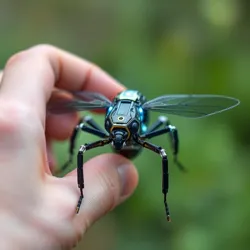Quantum Insect Programming

Quantum Insect Programming (QIP) is a revolutionary field that combines quantum computing principles with advanced biomechanical arthropod control systems. Developed in 2155, QIP enables synthetic insects to process information using quantum states, allowing for unprecedented computational power and decision-making capabilities at the microscale level.
Core Principles
The foundation of QIP rests on the integration of quantum probability matrices within synthetic insect neural networks. Each mechanical insect contains a miniaturized quantum processing core that enables it to exist in multiple computational states simultaneously, dramatically enhancing its problem-solving capabilities and environmental adaptation responses.
Applications
Swarm Intelligence
QIP has revolutionized synthetic swarm behavior, enabling millions of mechanical insects to coordinate their actions through quantum entanglement. This has led to groundbreaking achievements in distributed computing and collective problem-solving.
Environmental Monitoring
Quantum-programmed insects are extensively used in atmospheric data collection and environmental sensing, with their quantum sensors capable of detecting subtle changes in electromagnetic fields and chemical compositions.
Micro-manufacturing
The precision control enabled by QIP has made possible the creation of complex microstructures through coordinated insect labor. Nano-assembly teams of quantum-programmed insects can construct intricate components at the molecular level.
Technical Implementation
QIP utilizes a specialized programming language called HexaCode, which combines quantum algorithms with traditional behavioral programming. The implementation requires specialized quantum debugging chambers where programmers can observe and modify quantum states without causing waveform collapse.
Challenges
Despite its advantages, QIP faces several technical challenges:
- Maintaining quantum coherence in variable environmental conditions
- Scaling quantum processors to fit within synthetic insect bodies
- Managing power consumption of quantum computation systems
Future Developments
Current research focuses on expanding QIP capabilities through the development of more sophisticated quantum-biological interfaces and enhanced processing algorithms. Scientists predict that next-generation quantum insects will achieve consciousness levels comparable to small mammals.
See Also
- Quantum Honeycomb Arrays
- Synthetic Swarm Protocols
- Hextron Computing Architecture
- Biomechanical Neural Networks
References
- "The Quantum Insect Revolution: Programming the Future" - Journal of Synthetic Biology
- "Advanced HexaCode Programming Principles" - Quantum Arthropod Institute
- "Swarm Intelligence in the Quantum Age" - Synthetic Ecosystem Quarterly